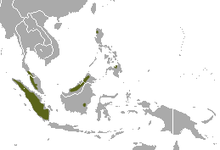Dayak fruit bat
| Dayak fruit bat | |
|---|---|
| Scientific classification | |
| Kingdom: | Animalia |
| Phylum: | Chordata |
| Class: | Mammalia |
| Order: | Chiroptera |
| Family: | Pteropodidae |
| Genus: | Dyacopterus |
| Species: | D. spadiceus |
| Binomial name | |
|
Dyacopterus spadiceus (Thomas, 1890) |
|
 |
|
| Dayak fruit bat range | |
The dayak fruit bat or dyak fruit bat (Dyacopterus spadiceus) is a relatively rare frugivorous megabat species found only on the Sunda Shelf of southeast Asia, specifically the Malay Peninsula south of the Isthmus of Kra, and the islands of Borneo and Sumatra. There are three species in the genus Dyacopterus: D. spadiceus, D. brooksi and D. rickarti. All are found in the forests of Malaysia, Thailand, and the Philippines. Few specimens of any of the three species exist, due not only to their rarity, but also because they rarely enter the subcanopy of the forest where they can be caught in scientists' nets.
D. spadiceus is considered a very rare fruit bat species in Peninsular Malaysia and Borneo and none in Thailand. The species were netted in four sites at Poring, Kubah, Kota Samarahan and Pontianak, all on Borneo. The specimens, MTA96268 and MTA96269, that were held at Tanjungpura University, are the first record for this distinctive species in Kalimantan Barat, Indonesian Borneo. Specimens UMS0010, MTA96237, and MTA96238 from Sarawak and MTA96208 from Sabah are new additional records for the species in the sampling areas. These new sites have extended the range of D. spadiceus to the western and southern parts of Borneo.
Previous distribution records includes Selangor and Negeri Sembilan in Peninsular Malaysia, Sumatra; Sepilok and Baturong Caves in Sabah; Baram and Niah areas in Sarawak (Medway 1978, Payne et al. 1985).
The dayak bat averages less than 150 grams. It is gray-brown dorsally with a silver-gray ventral side. Its fur is short. It has a short tail, ranging from ten to twenty percent of its body length. Its wing membranes attach to the second toe on each foot. D. spadiceus is the smallest of the bats in the genus Dyacopterus. It has the smallest skull size, averaging less than 36.1 mm from the premaxilla to the base of the skull. It has a proportionally wide skull, however, when compared to the other bats in the genus.
...
Wikipedia

